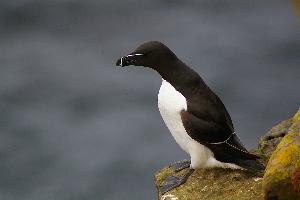
Váhy a míry
| Délka | od 19 do 21 cm |
|---|---|
| Délka rozpětí křídel | od 34 do 38 cm |
Popis zvířete
The Little Auk, scientifically known as Alle alle, is a fascinating and resilient seabird that belongs to the family Alcidae, which includes auks, guillemots, and puffins. This small yet hardy bird is primarily found in the cold waters of the Arctic, navigating some of the most challenging environments on Earth with remarkable adaptability.Measuring about 19 to 21 centimeters in length and weighing approximately 140 to 160 grams, the Little Auk has a compact body that is well-suited to its life in frigid habitats. Its plumage is predominantly black and white, with a stark contrast between the two colors that adds to its distinctive appearance. During the breeding season, the bird sports a black upper body and wings, with a white underside. A notable feature is its white face, which stands out against the darker feathers on the rest of its head. In the winter, its appearance changes slightly as it develops more white feathers around the head and neck area, providing it with a different seasonal look.
One of the most striking aspects of the Little Auk is its remarkable ability to thrive in the Arctic's extreme conditions. It nests in colonies on rocky cliffs and slopes, often choosing sites that are inaccessible to predators. The bird demonstrates incredible agility in the air, despite its small wings, which are more suited to 'flying' underwater. These wings allow the Little Auk to dive and propel itself with great efficiency, reaching depths of up to 30 meters in search of food. Its diet mainly consists of zooplankton, small fish, and crustaceans, which it captures with its small yet powerful beak.
The breeding season is a busy time for the Little Auk, with both parents involved in the care of their single egg. They take turns incubating the egg and later, feeding the chick, until it is ready to fledge. The colonies are often noisy and bustling with activity, as thousands of birds gather in close proximity.
Migration is another remarkable aspect of the Little Auk's life. While some populations are relatively sedentary, others undertake significant migrations to wintering grounds as far south as the North Atlantic, including the waters off the coasts of New England and the British Isles. During these migrations, the Little Auk faces numerous challenges, including storms and predation, demonstrating its resilience and adaptability.
The Little Auk plays a crucial role in the Arctic ecosystem, serving as both a predator and prey. It is a vital link in the food chain, helping to control the populations of small marine organisms while also providing food for larger predators. Its well-being is an indicator of the health of its Arctic habitat, making it an important species for environmental monitoring.
Despite its small size, the Little Auk is a species of immense interest and importance. Its ability to navigate the harsh conditions of the Arctic, combined with its role in the ecosystem, makes it a remarkable example of adaptation and survival. As climate change and human activities continue to impact its natural habitat, the conservation of the Little Auk and its environment becomes increasingly crucial for the biodiversity of the Arctic region.
Podobná zvířata
Nové fotografie zvířat
Top 10 zvířat
- Dolphin gull (Leucophaeus scoresbii)
- Diana monkey (Cercopithecus diana)
- Moustached guenon (Cercopithecus cephus)
- Galápagos tortoise (Geochelone nigra complex)
- Russian tortoise (Testudo horsfieldii)
- Japanese macaque (Macaca fuscata)
- Stone loach (Barbatula barbatula)
- Greek tortoise (Testudo graeca)
- Common flying dragon (Draco volans)
- Colossal squid (Mesonychoteuthis hamiltoni)


